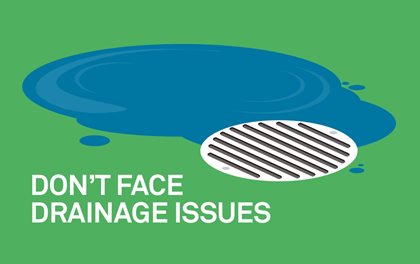Tuesday March 24, 2015
 Unless you live in an area where it hardly ever rains (in which case you have a whole other set of problems), drainage will be an issue in your community. Proper drainage is, of course, the answer, but getting there means you have to meet stringent requirements throughout different areas of your community.
Unless you live in an area where it hardly ever rains (in which case you have a whole other set of problems), drainage will be an issue in your community. Proper drainage is, of course, the answer, but getting there means you have to meet stringent requirements throughout different areas of your community.How can drainage problems be dangerous in your association?
Standing water is more than just unsightly -- it can also pose a safety threat and cause damage to your community’s buildings and surrounding concrete work, and potentially serve as a breeding ground for mosquitos. Puddling and pooling are usually caused when communities replace natural areas that absorb rainfall with built environments that don’t. Here are common issues and areas your community association or HOA should watch for so you can keep water (instead of your money) going down the drain.Common residential drainage problems and solutions
-
Open lawns.
Sometimes lawns and green belts are built without the necessary grading for water to flow into the stormwater system. In general, lawn areas should have a 1.5%–2% slope to help make this happen. If the design is such that the stormwater goes into a drainage channel (like a swale), then this water should dissipate within about 48 hours of the storm. For other areas, standing water should be gone within 24 hours. If your landscaped areas aren’t meeting these criteria, you may need to add a layer of topsoil to achieve the required grade.
-
Roads and drives.
For the most part, roads should be built with a minimum .5% slope leading to the nearest catch basin or other stormwater drainage system. Driveways should be much steeper, built with a 2% slope. You can tell if your roads and drives are meeting the minimum standards if standing water dissipates within 24 hours of a storm. Alternatively, you can use the “nickel test,” which dictates that no puddle on a roadway should be any deeper than a nickel’s thickness.
-
Detention basins.
Detention basins are designed to hold water before it can flow into a connecting storm water system at an adjacent property. The entire structure comprises an inlet system (typically a reinforced concrete pipe), the basin itself and a discharge outlet (usually a concrete box with openings at the bottom). The outlet structure is the area to watch... its openings are typically small and can easily clog. Be sure to maintain this part of the system by clearing the openings on a regular basis.
So what can you do if your roads, drives and detention basins aren’t meeting these standards? Consider connecting the downspouts from your buildings to an underground piping system that leads to a catch basin. If this isn’t an option, you can use what’s called an “infiltration system,” which allows water to be absorbed into the ground. Just be sure the soil you’re using complements the system.
Finally, if you’ve got open area residential drainage problems, additional lawn inlets located in lower areas can help. Connecting these lawn inlets to your overall stormwater management system will ensure optimal results. If this sounds complicated, don’t worry – a good property management company can refer your community to reputable engineers and service companies that can make it happen.